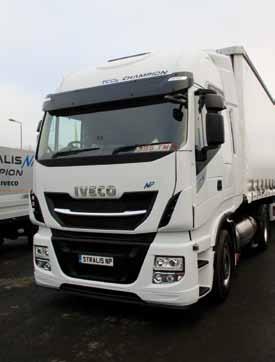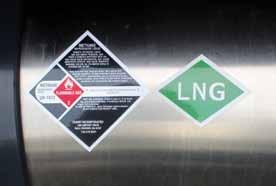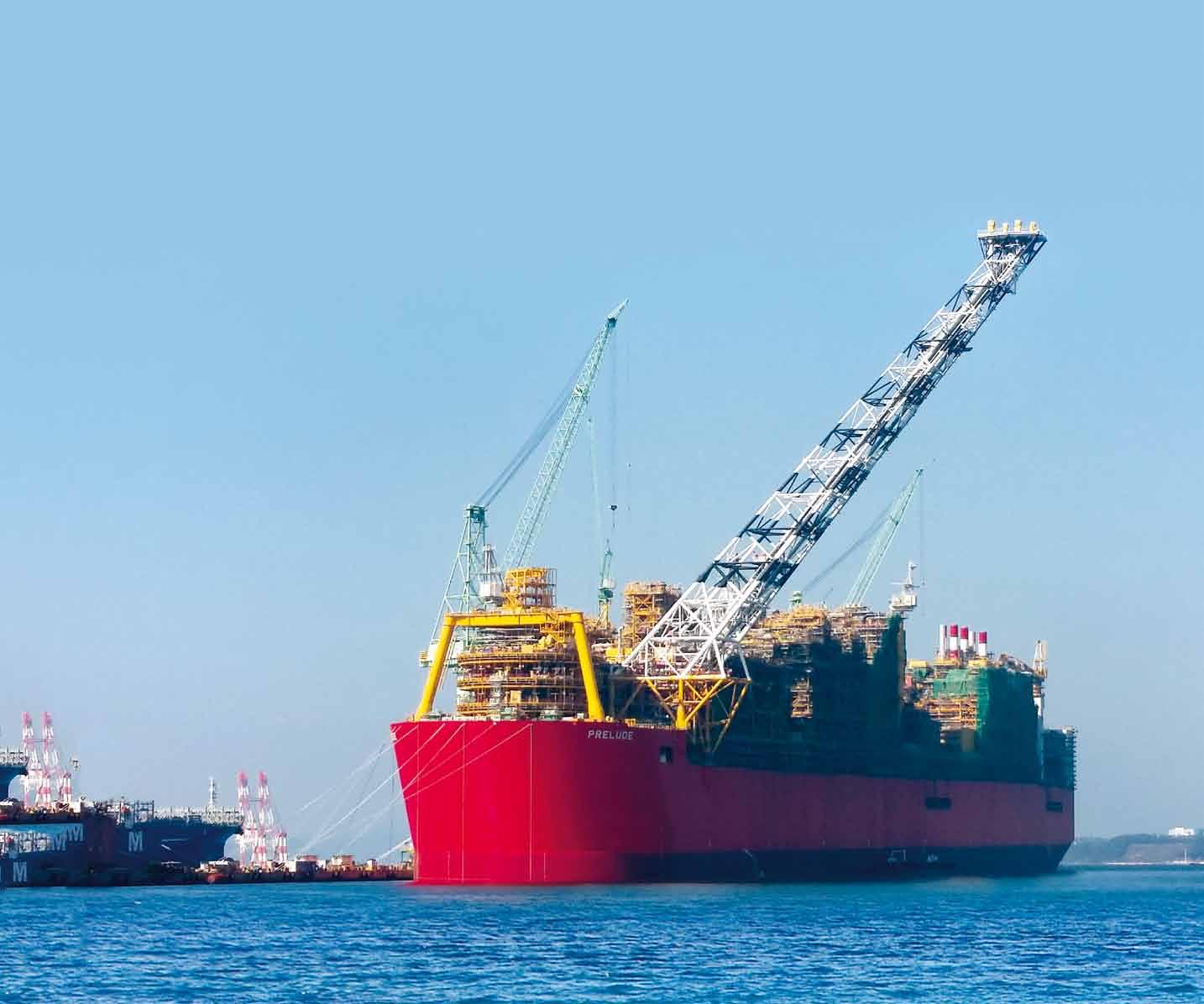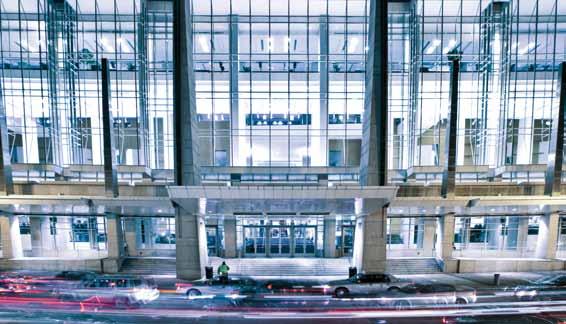
15 minute read
Torque of the town: the gas-powered era of road haulage is under way
by IGU
By Lee Gale
v The first Iveco New
Stralis NP arrived at Iveco’s UK headquarters in late January. The engine of this particular vehicle, the 8.7-litre Cursor 9 Natural Power Euro VI, runs on LNG.
Just 30 minutes by rail out of London’s Fenchurch Street you will reach Basildon in, what is often termed, ‘deepest, darkest Essex’. It’s a new town that was developed after the Second World War to accommodate the capital’s population overspill, an idea which, some say, ought to be revisited today. It is by no means a salubrious district but the inhabitants are fond of their cars, especially highperformance models. Immediately surrounding the rather raggedy Eastgate shopping precinct lies a sprawling housing estate and there, parked along its quiet thoroughfares, you will spy an inordinate amount of privately-owned registrations. A preponderance of beefed-up vehicles have plates starting with MI55 and BO55, suggesting many unmarried women and entrepreneurs.
Iveco New Stralis NP tractor 4x2 LNG
Cylinders: 6 Total displacement: 8,700cm 3
Power: 400hp Torque: 1,700 Nm LNG tank capacity: 540 litres left side, 540 litres right side Autonomy: 1,500km (930 miles) www.iveco.com
The UK headquarters of CNH Industrial lie beyond the boulevards of spoilers and chrome alloys on the A1235 Crane Farms Road which, for all intents and purposes, is a dragstrip. On foot, it is a life-in-your-hands dash across this dual carriageway to reach the comparative safety of the sizeable CNH compound with its rows of gleaming tractors and trucks. There are 12 brands within the CNH umbrella: the tractors are New Holland; the trucks, Iveco. It is an exciting time for the latter commercial-vehicle manufacturer. The first right-hand drive Iveco New Stralis NP (NP: natural power) truck has just arrived in the UK, still on test plates, and International Gas has been invited for a spin.
Gas-propelled trucks are, of course, nothing new. In fact, Iveco has been producing naturalgas commercial vehicles for over 20 years but the Italian firm is particularly perky about its long-haul New Stralis NP, featuring the 8.7-litre Iveco Cursor 9 Natural Power Euro VI engine, which can run on LNG and CNG. It could be said that Iveco is a natural-gas trailblazer, with more than 15,000 of its gas-powered goods vehicles already on Europe’s highways. It was the first commercial-vehicle producer to
seriously invest in natural-gas technology and now its forays into research and development are reaping rewards.
“It was the will of our Brand President, Pierre Lahutte,” explains Clément Chandon of Iveco Gas Business Development. “When he arrived in 2014 and had taken control of truck development, he said, ‘What shall we do?’ He understood that gas was one of the key products we should adopt. It’s a strategic product for us. We launched the New Stralis in 2016 and we’re now delivering our first units. It has been a tremendous success. We have 811 orders in our system and have an addition of 250 commitments from clients who are waiting for gas stations to open. It’s a good start.”
What is significant about the New Stralis NP is that it’s the first natural-gas truck to match diesel counterparts for power and torque output (400hp and 1,700 Nm respectively), while delivering 17% more power and 6% more torque than its nearest gas rival. It is also the first natural-gas truck with a 12-speed automatic gearbox and Eurotronic transmission, both conspiring to raise the truck’s driving experience while securing low fuel consumption. New-generation gas injectors, fuel rail and pistons have been created to bolster power and torque, while a three-way catalyst restricts emissions levels and noise. It’s Iveco’s intention to take gas trucks out of the niche market and into the mainstream.
With ambitious emissions-reduction targets following the Paris climate agreement in 2015, attitudes to fuel are changing. Today’s logistics sector is increasingly focused on environmental issues and with the EU reporting that a quarter of Europe’s greenhouse-gas emissions are caused by transport, green credentials are a powerful marketing tool.
To operate a CNG- or LNG-powered truck in Europe today, there has to be a certain amount of navigational pre-planning before embarking on a long run. C-LNG service stations are few and far between but once fully tanked up, the

New Stralis NP can travel 1,500km (930 miles), roughly the distance from Basildon to Vienna. The Europe-wide refuelling network is improving by the month and some of the continent’s foremost hauliers are putting their money where their mouth is. Jacky Perrenot in France has ordered 200 New Stralis NPs, Pe.tra srl in Italy has ordered 95 and Groupe Mauffrey, 42. Major French retailer Casino expects to be running 400 gas-powered Iveco artics by 2020, while supermarket giant Carrefour requires a mix of 270 rigids and artics this year alone. Sainsbury, Waitrose, Tesco and Asda have all requested tests.
“With the New Stralis, we are looking at 40-65% less in terms of emissions compared to diesel,” adds Chandon, “and we are up to 99% less in terms of particulates. It is amazing that we have achieved this. We have been able to drastically reduce fuel consumption because on a gas engine, all the particulates don’t come from fuel, they come from oil that is passing

c The New Stralis NP’s
greatest claim is that it is the first gas-powered truck to match the power output of its diesel equivalent. Fully tanked up, it will travel for 1,500km (930 miles).
c In the transition to
natural-gas power, the UK is lagging behind France, Italy, Spain and the Netherlands but Iveco expects the UK, as well as Germany, to become prominent markets for its NP vehicles.
Joining forces
By Antoni Peris
The international environmental targets set by COP 21, COP 22 and the European Union are highly demanding for everyone. Worldwide, countries must encourage efforts to ensure that global warming does not exceed 1.5ºC, while in Europe we need to reduce our domestic GHG emissions by at least 40% by 2030.
To achieve this reduction in emissions and alleviate the effects of global warming, it’s vital to change the energy system. A report drawn up by Deloitte entitled “A Sustainable Energy Model for Spain in 2050” states that an intelligent, flexible energy transition is required that ensures international economic and environmental objectives are met.
Natural gas can play a decisive role in the energy transition towards a low carbon-emission system but to achieve this, everyone – government, business, companies and other players in the national and international energy sector – need to work effectively and in coordination.
As the organisation that represents the Spanish gas industry and acts as an intermediary before state, regional and international governments, Sedigas will play a vital role over the coming years in promoting the use of gas as a key factor in the economic development of our country and in the world, as well as a guarantee of the quality of life of future generations.
Our country leads Europe in terms of LNG storage and regasification capacity with 40% and 32% of Europe’s total capacity, respectively. It also has a wide range of different natural gas sources and is a world leader in terms of knowledge and use of LNG technology.
According to the report entitled “El papel del gas natural en una economía española baja en emisiones” (The role of

natural gas in a low-emission Spanish economy), drawn up by KPMG in collaboration with Sedigas, Spain’s particular features (including its gas infrastructure) could also help our country meet EU targets. Moreover, in a scenario in which natural gas accounts for 33% of the energy mix, our country could achieve savings of up to €223 million per year.
That’s why we believe that Spain, given its geographical situation, its knowledge and infrastructures, must become a gateway for natural gas to Europe and the rest of the world. And to achieve this, at Sedigas we will strive, over the coming years, to boost the penetration of natural gas in transport and the presence of natural gas in the domestic and tertiary sectors.
However, energy companies also need to make a greater effort. One case in point is Gas Natural Fenosa which, in accordance with its strategic view presented last year, expects to invest over €5.1 trillion in natural gas distribution networks throughout the world between 2016 and 2020 in order to take advantage of the great potential in Spain and Latin America, especially in the gasification projects of Mexico, Colombia and Chile. The company’s aim is to increase the number of supply points by 1.4 million in 2018 and by an additional 1.2 million in 2020.
Gas Natural Fenosa is also a benchmark in environmental terms. The company devotes considerable effort to bring its operations in line with values such as sustainable development, combatting climate change and protecting biodiversity with the aim of becoming a key player in Spain in the reduction of carbon emissions.
Initiatives such as its Environment Reports, analysing the company’s environmental performance and including, for example, a calculation of its carbon footprint, as well as its involvement in and promotion of projects to develop technologies related to renewable gas sources, are just some examples that have led the company to be recognised by prestigious sustainability indices such as the Dow Jones Sustainability Index, the Carbon Disclosure Project, the FTSE4Good and the EuroNext Vigeo, among others.
We are certainly facing a future in which natural gas will play a key role in the energy mix. According to EU targets, natural gas consumption should account for around 30% of all final energy consumption by 2030, compared with the current level of 19%. But to achieve this, the energy industry and governments must establish a long-term strategy. The gas market needs a road map up to 2030 that contributes towards sustainable energy growth. And this will only be possible if we all join forces.
Antoni Peris is Chairman of Sedigas and Managing Director of Regulated Business at Gas Natural Fenosa.
through the piston rings. So we beat diesel with a particulate filter. In the city, we are more equal to diesel because there is an efficiency gap at low speeds but once the truck is on the open road, the engine efficiency is much better. And with the Euro VI, there is 10-15% less CO 2 .”
France, Italy, Spain and the Netherlands are Europe’s leading markets for natural-gas haulage. Germany is at the beginning of its journey, as is the UK, although Iveco expects both to become prominent natural-gas users in the near future. On the continent, there will be 45 C-LNG fuel stations by the end of 2017. While less-polluting vehicles are obvious attractions for operators and customers alike, Iveco has announced that the total cost of ownership of its new gas-powered truck will be 7% lower than diesel equivalents. As natural gas is less expensive than diesel in many European countries, the savings really start to mount.
Of course, cold, hard figures are one thing but the proof of the pudding is in the eating. It is a raw afternoon in Basildon, with a windchill factor that is more Archangel than Essex. With its long-distance Hi-Way cab, giving 2m of internal height and 10m 3 space, the New Stralis NP is a lofty beast and an ideal shelter from the cruel Arctic blasts. Instantly noticeable is the size of the twin, stainless-steel LNG fuel tanks, both of which are, in fact, a tank within a tank, with a vacuum between to provide insulation. Thermos flasks work on the same principle. In no way do the long-distance, elongated tanks detract from the aesthetic of, what is actually, a very good-looking vehicle.
“Jump inside, the door’s open,” calls Martin Flach, Director, Alternative Fuel at Iveco, who also handily carries a HGV licence. Three steps up and you’re inside the cab with a commanding view of the frozen Essex lows. At first glance, everything appears ergonomically precise. Even the steering wheel and high-backed leather seat are welcoming. Flach fires the engine and the first thing you notice is how quiet it is. In fact, at 72dB, its 3dB quieter than its diesel equivalent. The accelerator is squeezed and through the passenger-side mirror, white, fluffy whisps can be seen drifting from the exhaust pipe. “People think it’s kicking out a tonne of harmful fumes because they’re so used to seeing diesel trucks,” Flach adds. “It’s mostly water vapour.”
We swing out onto the Basildon racetrack and it is little surprise to see, 50m along from the entrance to CNH Industrial’s compound, three cars on a sliproad at various awkward angles amidst the flashing lights of police and paramedics. The impact must have taken place at high velocity because the bonnet of each vehicle has concertinaed. Following a brief discussion on the falling standards of British driving, we pick up the Southend Arterial Road and navigate roundabouts towards the M25 London Orbital. All the while, cars whose names invariably end with an “i” zip through tight spaces as if we’re in an arcade game before hurtling off into the distance. Thankfully, Flach is a patient driver and with the wintry sun briefly bathing us in glorious golden light, Essex, with its profusion of scrapyards, golf courses and trading estates, could almost be described as picturesque.
“Some time back, whenever I was involved with civil servants and politicians, it was all, ‘Electric, electric, electric,’” Flach recalls. “I was viewed as an old git from from the commercialvehicle industry. I’d tell them, ‘No, electric works for small vehicles but electrics are not the answer for heavy commercial vehicles. The answer’s gas.’ And they’d look at me as if I was crazy. The encouraging thing is that in the last couple of years, they’re no longer saying, ‘Gas isn’t the answer.’ They’re saying, ‘Gas is the right answer for commercial vehicles.’ Because there isn’t anything else which competes with it in the short term. Hydrogen hasn’t got the energy density. In the space available, you just can’t physically store the stuff. And there’s a price saving too. Diesel will cost you $62,500 a year if you’re covering 160,000km [100,000 miles]; gas will save 25% on an operator’s fuel bills and the UK government has guaranteed to
maintain the fuel duty differential between gas and diesel until 2024.”
There’s little doubt that a lorry driver’s existence isn’t life’s easy option but if the New Stralis NP were headed for a distant drop in, say, the Algarve, there would be few complaints from this passenger today. We leave the M25 at Thurrock and rumble along Essex A-roads, skirting kart circuits, windswept sites for upcoming car-boot sales and Harvester pubs with their special offers on comprehensive chicken menus. North Stifford, Chafford Hundred and Fobbing slip by, while local MI55es and BO55es weave and dart in a furious race for home and hearth. Essex, it seems, is a county that is perpetually set on fast-forward.
Back in the calm of CNH Industrial’s yard, Flach mentions the need to get the right-hand drive New Stralis NP registered and out to potential clients. “If some of the major UK players could have this Stralis tomorrow, they’d take it off me,” he says. “They’re ready, they want to trial it. There’s a whole load of people clamouring to get it first.”
It seems that the transition from diesel to natural gas is already gearing up. By 2025, there will be an extensive network of naturalgas service stations in Europe, with a maximum distance of 150km (93 miles) between CNG fuel points and 400km (249 miles) for LNG. By this time, railways may also be running substantial fleets of natural-gas-powered freight locomotives, meaning the future of goods delivery by land, whether road or rail, will be significantly less polluting – and quieter.
Further environmental benefits will come with biomethane-fuelled trucks. The natural-gas New Stralis NP reduces CO 2 emissions by 15% compared to diesel but running on biomethane, where gas from rotting organic matter is transformed into a usable energy, it’s a 95% reduction. Chandon is enthused by the prospect of power from waste.
“It can be liquid waste, agricultural waste, water waste, it can be from the food industry;

we have it in great quantity,” he states. “It’s full of energy. So it’s encouraging that biomethane is developing and from problems, we create a very nice solution. Biomethane is the perfect fuel for trucks, with close to zero emissions and it’s neutral in CO 2 . A 40-tonne truck will give you the footprint of half a Smart car. You produce energy locally and at the end of the chain you have fertiliser that could be used for agriculture and CO 2 that can be used for raising a crop. You can also use CO 2 for cooling a refrigerated trailer. Liquid biomethane for the truck and liquefied CO 2 for the fridge. It’s a perfectly carbon-free vehicle which will travel 1,500km.”
Analysts at Shell and the Institut Français du Pétrole believe that by 2050, there will be more gas vehicles on Europe’s roads than diesel or petrol. Chandon has shorter targets than this but it’s now apparent that by the time some of us are filling in forms for old-people’s homes, trucks will be a sustainable transport for freight delivery. Whether the incidence of reckless driving in Essex will have declined by then remains unlikely.
Lee Gale is Editor-in-Chief of International Systems and Communications Limited.
c The New Stralis NP will
give a 40-65% emissions reduction compared to diesel and 99% less particulates. Major European hauliers like Jacky Perrenot in France and Pe.tra srl in Italy have placed orders.











